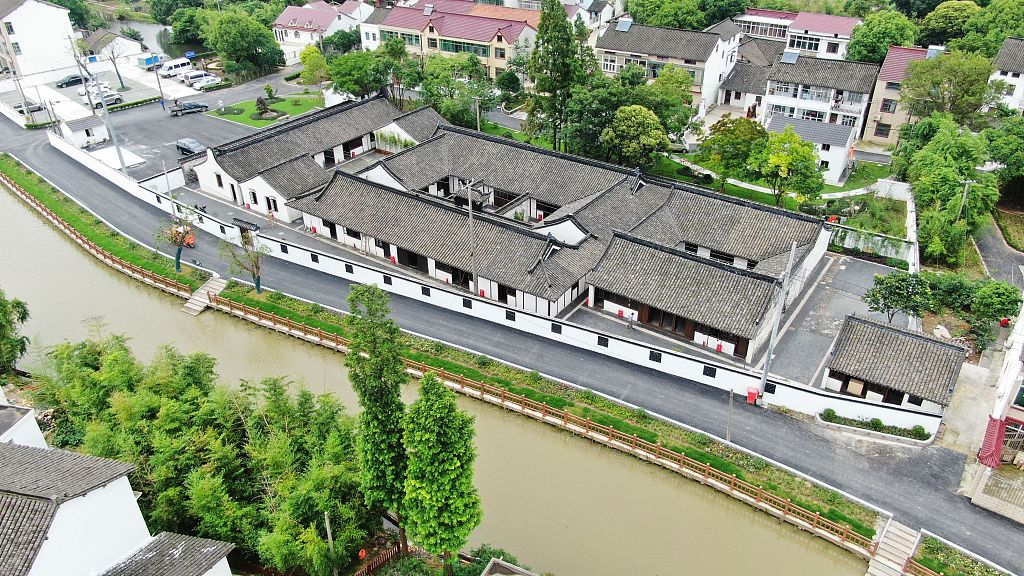
The birthplace home, former residence and a themed library of Fu Lei, a 20th-century Chinese translator, writer, educator and art critic opened to the public on Saturday in Shanghai.
The birthplace home of Fu Lei
Fu was born in a riverside home, occupying an area of 1,500 square meters, in the village of Wanglou in Shanghai's Pudong New Area.

An aerial view of the birthplace home of Fu Lei. /VCG Photo
The abode, consisting of 36 rooms, was built in the Ming Dynasty (1368-1644), and renovated in the late Qing Dynasty (1936-1912). Time left its mark on the house, which underwent six months of renovation before opening to the public.
Fu lived there before the age of four. The house has now been turned into a museum, where visitors can learn about the highlights and major events of Fu's childhood and his later life, including the period following his return from France where he studied at a young age.
The exhibits and illustrations are divided into three sections covering his life, the Fu family's education and traditions, and letters exchanged between Fu and his son.
A house accommodating the master as a teenager
After the age of four, Fu moved to Zhoupu, a small town miles away from his birthplace, along with his mother. They settled down in a rented house until he was 19. The house witnessed the teenage years of Fu, which are thought to have influenced the erudite later in life.

The house Fu Lei lived in between the age of four and 19. /VCG Photo
At that time, Fu's mother invited a private tutor to teach him at home. Sitting in a small room next to the study, the mother supervised her son through a window while doing needlework. She is said to have closely monitored her son's studying sessions until she could recite the lines in books before Fu could.

A room of the house where Fu Lei spent his adolescent times. /VCG Photo
According to the family's diary, the mother decided to move houses because she believed the one in Wanglou was too noisy to study in.
Fu Lei themed library: Inspiring the next generation
Zhoupu is also home to a Fu Lei themed Library — the only one in China.
The library spans an area of 5,500 square meters and houses more than 200,000 books and 200,000 electronic publications. The operators of the library aim to gradually double the current collection.

The Fu Lei Literature Hall in Fu Lei Library. /VCG Photo
In the Fu Lei Literature Hall, a large number of photos, manuscripts, and publications are on display. Those looking to know more about the two houses where Fu lived can also find answers to their questions there. Fu's translated work, writings and studies about him are also part of the library's collection.
The library has also set up a reading corner for children, with playful bookcase designs.

A special reading corner for kids at the Library. /VCG Photo
The library plans to hold seminars especially for young adults and children to help them better understand Fu's literature heritage and his spirit.
Fu Lei (1908-1966) is a well-known master in literature, translation, and education.
"Home Letters by Fu Lei," a collection of family letters between Fu Lei and his wife Zhu Meifu, and their eldest son Fu Cong during the 1950s and early 1960s, is regarded as a classic read, excerpts of which are included in middle school textbooks.

A paper features the photo of young Fu Lei and his wife, Zhu Meifu. /VCG Photo
Fu translated a number of French novels into Chinese, including renowned pieces like "Eugenie Grandet" and "Le Père Goriot" by Honoré de Balzac, and "Vie de Tolstoï " by Romain Rolland. His translation in accordance with the text’s spirit, rather than the language format, profoundly influenced Chinese translation theories and later scholars.

Copyright © 2018 CGTN. Beijing ICP prepared NO.16065310-3
Copyright © 2018 CGTN. Beijing ICP prepared NO.16065310-3